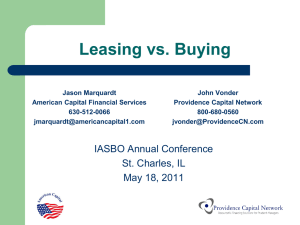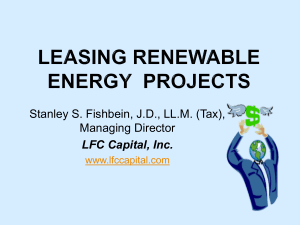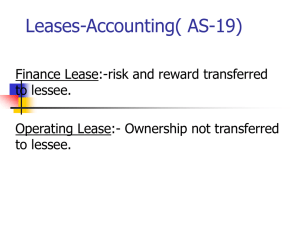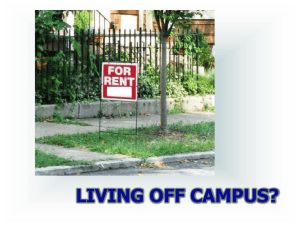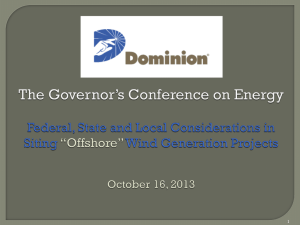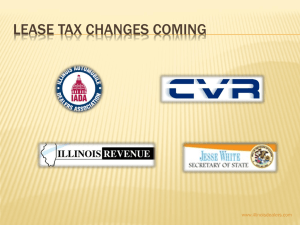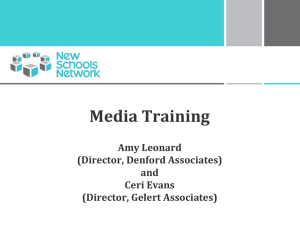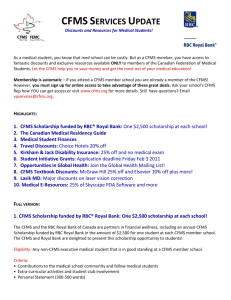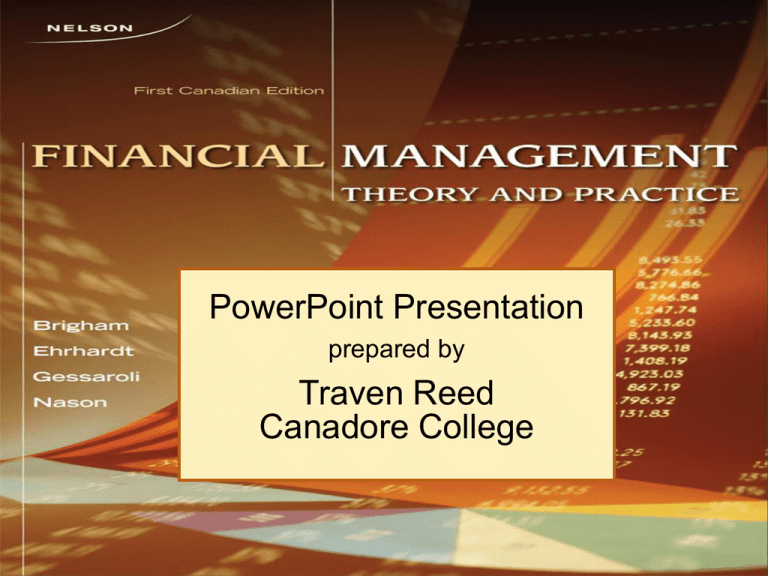
PowerPoint Presentation
prepared by
Traven Reed
Canadore College
chapter 15
Lease Financing
Corporate Valuation and
Lease Financing
CH15
Copyright © 2011 by Nelson Education Ltd. All rights reserved.
15-3
Topics in Chapter
CH15
•
•
•
•
•
•
Types of leases
Tax treatment of leases
Effects on financial statements
Lessee’s analysis
Lessor’s analysis
Other issues in lease analysis
Copyright © 2011 by Nelson Education Ltd. All rights reserved.
15-4
Who are the two parties to
a lease transaction?
CH15
• The lessee, who uses the asset and
makes the lease, or rental,
payments.
• The lessor, who owns the asset and
receives the rental payments.
• Note that the lease decision is a
financing decision for the lessee
and an investment decision for the
lessor.
Copyright © 2011 by Nelson Education Ltd. All rights reserved.
15-5
What are the five primary
lease types?
CH15
• Operating lease
– Short-term and normally cancelable
– Maintenance usually included
• Financial lease
– Long-term and normally noncancelable
– Maintenance usually not included
• Sale and leaseback
• Combination lease
• "Synthetic" lease
Copyright © 2011 by Nelson Education Ltd. All rights reserved.
15-6
How are leases treated for
tax purposes?
CH15
• Leases are reviewed by CRA to
determine if they are an actual lease or
conditional sale.
• For an actual lease the full lease
payment is deductible.
• If the lease did not meet the CRA
guidelines then the lessee would treat
the asset as a purchase and only deduct
CCA and the interest portion of the lease
payments.
Copyright © 2011 by Nelson Education Ltd. All rights reserved.
15-7
How does leasing affect a
firm’s balance sheet?
CH15
• For accounting purposes, leases are
classified as either capital or
operating.
• Capital leases must be shown directly
on the lessee’s balance sheet.
• Operating leases, sometimes referred
to as off-balance sheet financing,
must be disclosed in the footnotes.
• Why are these rules in place?
Copyright © 2011 by Nelson Education Ltd. All rights reserved.
15-8
CICA Section 3065
CH15
• Firms entering a financial lease contract
are obligated to make lease payments
as if they had signed a loan agreement
• Fail to make lease payments is taken as
a default on interest/principal can
bankrupt a firm
• To capitalize a lease, the present value
of the lease payments is shown as debt.
• The same amount is shown as a fixed
asset.
Copyright © 2011 by Nelson Education Ltd. All rights reserved.
15-9
Impact on a firm’s capital
structure
CH15
• Leasing is a substitute for debt.
• As such, leasing uses up a firm’s
debt capacity.
• Assume a firm has a 50/50 target
capital structure. Half of its assets
are leased. This has the effect of
raising its true debt ratio, and thus
its true capital structure is changed.
Copyright © 2011 by Nelson Education Ltd. All rights reserved.
15-10
Lessee’s Evaluation
CH15
•
•
•
•
•
2-year-life equipment cost: $100.
Loan rate on equipment = 10%
Marginal tax rate = 40%
Class 12, 100% CCA rate
If borrow and buy, a 2-year simple loan
requires $10 interest at ending of each
year and $100 repayment at = 2
• Residual value at t = 2: $0
• Maintenance cost: $0
Copyright © 2011 by Nelson Education Ltd. All rights reserved.
15-11
Other Information for Lease
CH15
• If the equipment is leased:
– Lease contract runs for 2 years
– Lease meets CRA guidelines to
deduct lease payments for tax
purposes
– Lease payment will be $55 at the end
of each year
Copyright © 2011 by Nelson Education Ltd. All rights reserved.
15-12
CCA Schedule for Owning
CH15
• Owner is entitled to the CCA and
the interest deductions
Year UCC before
CCA
CCA
@100%
UCC after
CCA
Tax Saving
from CCA
1
$100
$50
$50
$20
2
50
50
0
20
• Note the CCA tax shield for Year 1,
is: $100 x 1 x ½ = $ 50
$ 50 x 0.40 = $ 60
Copyright © 2011 by Nelson Education Ltd. All rights reserved.
15-13
Cash Flow Time Line:
Borrow-to-buy
CH15
Equipment cost
Inflow from loan
Interest expense
0
($100)
100
1
2
($10)
($10)
Interest tax savings
Principal repayment
CCA tax savings
NCF
0
PV@6% cost of buying= $63.33
Copyright © 2011 by Nelson Education Ltd. All rights reserved.
4
4
($100)
20
20
$14 ($86)
15-14
Why use 6% as the discount rate?
CH15
• Leasing is similar to debt financing.
– The cash flows have relatively low risk; most
are fixed by contract.
– Therefore, the firm’s 10% cost of debt is a
good candidate.
• The tax shield of interest payments must
be recognized, so the discount rate is:
10%(1 - T) = 10%(1 - 0.4) = 6.0%
Copyright © 2011 by Nelson Education Ltd. All rights reserved.
15-15
Cash Flow Time Line:
Leasing
CH15
0
Lease pmt
Tax savings from
payment
NCF
1
2
($55) ($55)
22
22
0 ($33) ($33)
PV cost of leasing @ 6% = $60.50
Copyright © 2011 by Nelson Education Ltd. All rights reserved.
15-16
What is the net advantage to
leasing (NAL)?
CH15
• NAL = PV cost of owning - PV cost
of leasing
= $63.33 - $60.50
= $2.83 > 0
• Should the firm lease or buy the
equipment? Why?
• Lease because NAL > 0 implying
leasing is cheaper than buying.
Copyright © 2011 by Nelson Education Ltd. All rights reserved.
15-17
What is the net advantage to
leasing (NAL)? (cont’d)
CH15
• Note that we have assumed the
company will not continue to use
the asset after the lease expires;
that is, project life is the same as
the term of the lease.
• What changes to the analysis would
be required if the lessee planned to
continue using the equipment after
the lease expired?
Copyright © 2011 by Nelson Education Ltd. All rights reserved.
15-18
Residual Value Consideration
CH15
• In leasing, the asset’s value at the end of the
lease is called residual value.
• Assume the RV could be $0 or $400,000, with
an expected value of $200,000. How could this
risk be reflected?
• The discount rate applied to the residual value
inflow (a positive CF) should be increased to
account for the increased risk.
• All other cash flows should be discounted at the
original 6% rate.
Copyright © 2011 by Nelson Education Ltd. All rights reserved.
15-19
Residual Value Consideration
(cont’d)
CH15
• If the residual value were included
as an outflow (a negative CF) in the
cost of leasing cash flows, the
increased risk would be reflected by
applying a lower discount rate to
the residual value cash flow.
• Again, all other cash flows have
relatively low risk, and hence would
be discounted at the 6% rate.
Copyright © 2011 by Nelson Education Ltd. All rights reserved.
15-20
Effect of Increased Residual Value
Uncertainty
CH15
• The lessor owns the equipment
when the lease expires.
• Therefore, residual value risk is
passed from the lessee to the
lessor.
• Increased residual value risk makes
the lease more attractive to the
lessee.
Copyright © 2011 by Nelson Education Ltd. All rights reserved.
15-21
Lessor’s analysis
on the lease transaction
CH15
• To the lessor, writing the lease is an
investment.
• Therefore, the lessor must compare
the return on the lease investment
with the return available on
alternative investments of similar
risk.
Copyright © 2011 by Nelson Education Ltd. All rights reserved.
15-22
Lessor Evaluation
CH15
• Lease payment = $320,000 at the
beginning of each year
• Cost of equipment = $1,000,000
• Loan rate on equipment = 10%
• Marginal tax rate = 40%
• Class 43, 30% CCA rate
• 4- year maintenance contract costs
$20,000 at the beginning of each year
• Residual value at t = 4: $200,000
Copyright © 2011 by Nelson Education Ltd. All rights reserved.
15-23
Time Line: Lessor’s Analysis
(In Thousands)
CH15
0
Cost
1
2
3
4
60
102
71.4
49.98
-20
-20
-20
-20
8
8
8
8
320
320
320
320
-128 -128
-128
-128
-1,000
CCA tax shield
Maint
Tax sav
Lse pmt
Tax
RV
200
RV tax
NCF
-80
-804
240
282 251.4
Copyright © 2011 by Nelson Education Ltd. All rights reserved.
169.98
15-24
Time Line: Lessor’s Analysis
(In Thousands – cont’d)
CH15
• The NPV of the net cash flows,
when discounted at 6%, is $19,114
• Should the lessor write the lease?
Why?
• Yes! If the lease’s NPV is greater
than zero, then the lease should be
written.
Copyright © 2011 by Nelson Education Ltd. All rights reserved.
15-25
Remarks
CH15
• If all inputs for leasing analysis are
symmetrical between lessee and
lessor, leasing is a zero-sum game.
• The lessor’s cash flows would be
equal, but opposite in sign, to the
lessee’s NAL.
• What are the implications?
• Differences between lessees and
lessors must exist to support a lease
Copyright © 2011 by Nelson Education Ltd. All rights reserved.
15-26
Issues of Cancellation Clause
CH15
• A cancellation clause would lower
the risk of the lease to the lessee
but raise the lessor’s risk.
• To account for this, the lessor
would increase the annual lease
payment or else impose a penalty
for early cancellation.
Copyright © 2011 by Nelson Education Ltd. All rights reserved.
15-27
Other Issues in Lease
Analysis
CH15
• Do higher residual values make
leasing less attractive to the
lessee?
• Is lease financing more available or
“better” than debt financing?
• Is the lease analysis presented
here applicable to real estate
leases? To auto leases?
Copyright © 2011 by Nelson Education Ltd. All rights reserved.
15-28
Other Issues in Lease
Analysis (cont’d)
CH15
• Would spreadsheet models be
useful in lease analyses?
• What impact do tax laws have on
the attractiveness of leasing?
Copyright © 2011 by Nelson Education Ltd. All rights reserved.
15-29
Numerical analyses often indicate that
owning is less costly than leasing. Why,
then, is leasing so popular?
CH15
• Provision of maintenance services.
• Risk reduction for the lessee.
– Project life
– Residual value
– Operating risk
• Portfolio risk reduction enables
lessor to better bear these risks.
Copyright © 2011 by Nelson Education Ltd. All rights reserved.
15-30
Reasons for Leasing
CH15
• Leasing is driven by various
differences between lessees and
lessors. Top three motivations:
– Tax rate differentials
– Lessors are often better to bear the
residual value risk than lessees
– Lessors can maintain the leased asset
more efficiently than lessees
Copyright © 2011 by Nelson Education Ltd. All rights reserved.
15-31


